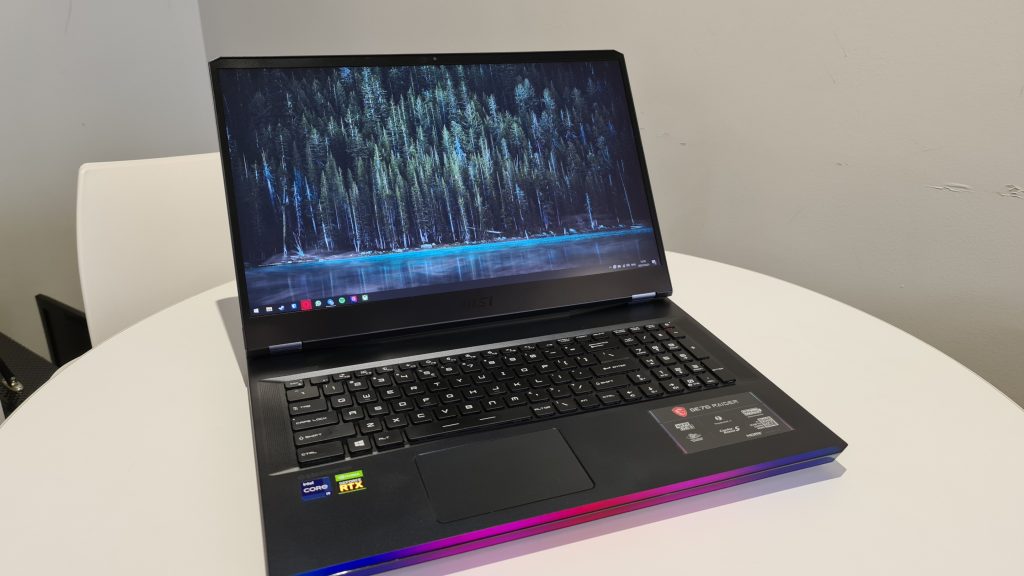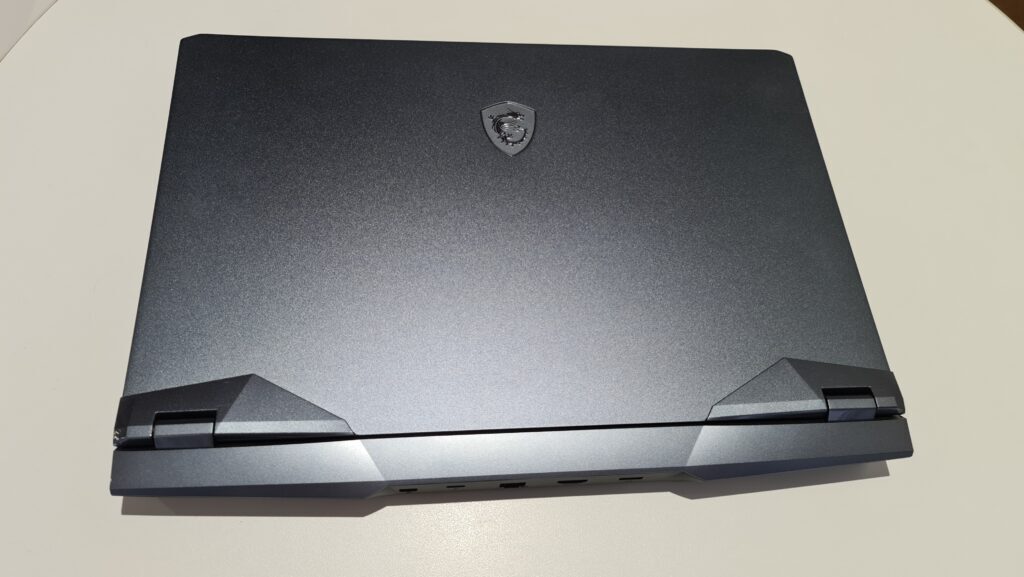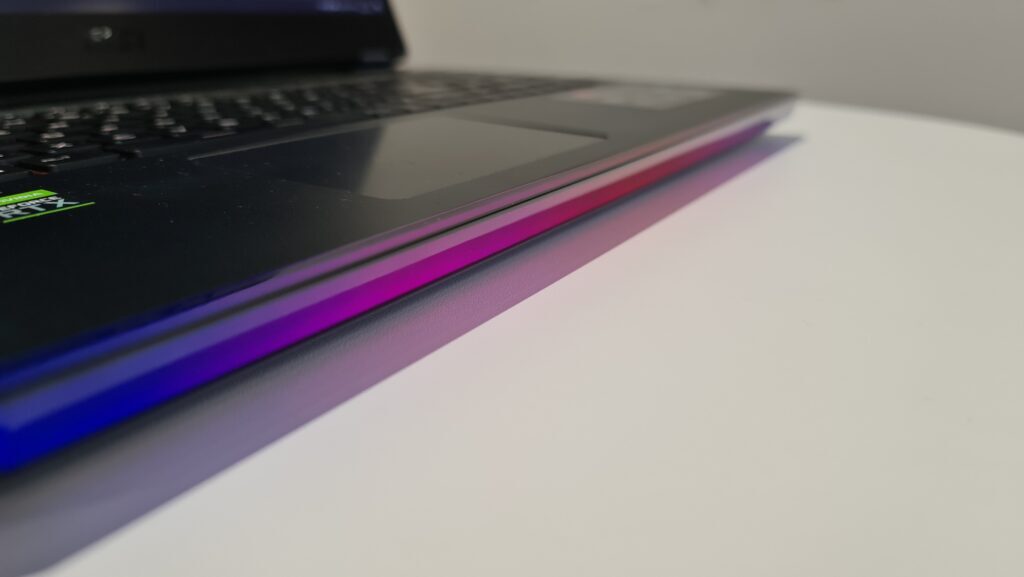If you’re looking for the most powerful mobile gaming experience money can buy, and you have a lot of that last thing, then the MSI GE76 Raider is what you need, depending on how loose your definition of ‘mobile’ is.
-
Design
-
Display
-
Performance
-
Price
-
Features
As far as gaming laptops go, there’s a limit to what manufacturers can do with the traditional form factor. This is one of the reasons some of them are trying new things like adding a second screen (although that doesn’t add much in the way of performance) or having the GPU sit outside the chassis.
But most of the time, no matter how many high-end specs they cram into a laptop, there will always be issues with thermals, acoustics and trying to find a good balance between the two. It can’t get too hot or it won’t perform but when cooling it, you can’t let it get too loud or you won’t be able to use it. If you’re spending R80,000 – R104,000 on a gaming laptop like the MSI GE76 Raider, you’d expect it to straddle that balance perfectly. So does it?
What’s in the box?
The chassis of the GE76 Raider is pretty much the same as the previous version that came out at the beginning of the year with Intel 10th-gen processors so that remains largely unchanged. The angular design elements and titanium blue colour are supposed to, according to MSI, resemble a spaceship. We’ve not that crazy about it because it shouts “Look at me I’m a gamer!” a little too loud for our liking. You might get a few sideways glances if you also need to use your laptop in a professional environment.
Light up your life
The thing you’ll first notice when you power up the Raider is the mystic lighting bar that spans the front bottom lip of the laptop. We think it’s one of the best implementations of RGB in a gaming laptop we’ve seen in recent years. If you’re a fan of this sort of thing then you’ll be happy to know it’s fully customisable through the included Steelseries software. It’s a pity it doesn’t get as bright as shown in the marketing material.
Plug in
On to ports now and the GE76 Raider features pretty much everything you’d expect, where you’d expect to find it. Ports that should be on the back are and the ports you’d tend to use more often, like USB slots are along the sides. Along the back, you’ll find the DC power socket along with an HDMI 2.1, mini Display Port 1.4, 2.5G ethernet port and a Thunderbolt 4 port. You also get WiFi 6E and Bluetooth v5.2 for wireless connectivity.
Along the right side, you’ll find two USB Type-A 3.2 Gen-1 ports and a full-sized SD card reader. Along the left is where the single USB Type-A 3.2 Gen-2, USB Type-C 3.2 Gen-2 and the headphone/mic combo jack live.
Internally, this comes with two M.2 SSD slots. One PCIe Gen 4.0 and one Gen 3.0 slot. One of these will be populated with whatever storage option you go for. Ours came with the 1TB option but there are also 2TB, 4Tb and 8TB options.
Would you look at this
The Raider comes with four options for the display panel all of which are 17.3in. If you’re a competitive gamer and are trying to make it in the professional scene or you just value refresh rate over everything else there’s the 360Hz FHD (1920×1080) option. If you play a variety of games and also want your video content to look decent there are two QHD (2560×1440) options with 165Hz and 240Hz refresh rates. Then you get the 120Hz UHD (3840×2160) that our review unit came with.
If you have the option to choose, go for one of the QHD options. QHD remains the sweet spot for gaming, even more so in smaller form factors. While 4K looks great, at this size the increase in pixel count over QHD isn’t noticeable, it draws more power and as we said earlier, there’s only so much performance you can get from this form factor. Even though this machine is one of the most powerful gaming laptops on the market, it struggles to reach 120fps in most games at 4K – more on that later.
The bells and whistles
You get a pretty decent set of peripherals here. The partnership with Steelseries for the keyboard means the typing experience is good. Not great though, there’s no mechanical keyboard option and for what you’re paying that’s quite a letdown. You do get per-key RGB lighting which is also fully customisable through the software.
The onboard audio was surprisingly good for a gaming laptop. You get four speakers in total, two subwoofers and two full-range stereo units. They get plenty loud enough and with the Nahimic software, you can tweak the sound to your liking.
For the webcam, you get a 1080p30fps cam which, you know, gets the job done we suppose. In a similar vein, the trackpad is also ‘just fine’. It’s a little small by today’s standards which, again, for what you’re paying, is disappointing. You’re not going to be using it when gaming though, we hope.
Powering all this is a rather large 99.9WHr battery. While that is a seriously big juice box, with the power-hungry CPU, GPU, 4K screen and all that RGB, it won’t last you very long. You’ll get, at most, about 5hrs from it. That’s with battery mode enabled and a light workload. You’ll need that power brick and a wall socket if you want to do anything more.
Under the hood
On to what really matters here, performance. The review unit we got is the higher-end configuration with Intel’s i9-11980HK CPU, Nvidia’s 3080 GPU and 64GB of RAM. They are the fastest CPU and GPU currently available.
This CPU from Intel has finally closed the gap that AMD created with its Zen 3 Ryzen series chips. It is still based on the older 10nm process but, staying on the same process since 2018, Intel has managed to squeeze every last drop of performance out of it. The 45-65W of power the chip draws is used to feed the 8 cores and 16 threads, all with a base frequency of 3.3GHz and a turbo frequency of 5.0GHz.
This is the unlocked version of the chip as well which means the CPU will give you everything it has to offer until it reaches its thermal limit. On the way up to that thermal limit, we hope you’re wearing headphones because the fans will get very loud as they attempt to keep temps low.
This 3080 chip, while still fairly powerful, is limited to 165W so it can’t quite stretch its legs to the fullest. That being said, it is by no means incapable. Even in the unoptimised disappointment that is Battlefield 2042 you still get a decent 80-100fps if you’re willing to sacrifice some visual fidelity. In better-optimised titles, like League of Legends, Doom Eternal or Red Dead Redemption 2 you’ll have a much better experience. When scaling the render resolution down or choosing a lower-res screen option, this will have no problem running pretty much anything you throw at it.
And for when you need just a little extra performance, MSI Centre allows you to overclock the CPU and GPU slightly. Just don’t do that in a library, the two internal fans are going to sound like the thing is trying to take off.
MSI GE76 Raider verdict
If you’re looking for the most powerful mobile gaming experience money can buy, and you have a lot of that last thing, then the MSI GE76 Raider is what you need, depending on how loose your definition of ‘mobile’ is. The size and weight of the laptop and power brick won’t fit everyone’s description of mobile but if you get the QHD display option or hook it up to an external one, you’ll struggle to find better performance in a similarly sized package.
The MSI GE76 Raider is available from Evetech.co.za starting at R80,000.


